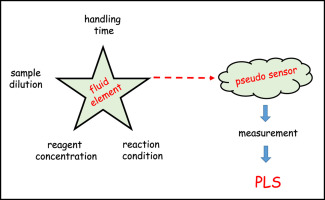Talanta ( IF 6.1 ) Pub Date : 2017-10-24 , DOI: 10.1016/j.talanta.2017.10.037 Eliezer Oliveira , Camelia Henriquez , Lidiane C. Nunes , Elias A.G. Zagatto

|
Multivariate calibration involving partial least squares was exploited in the flow-based spectrophotometric determination of molybdenum in river waters relying on the Mo(VI)-catalyzed iodide oxidation by H2O2 under acidic conditions. Two sample aliquots were simultaneously inserted into the carrier stream, and differential pumping was accountable for in-line addition of sulfuric acid to one of them. Pronounced gradients (acidity and reagent concentrations) were established along the complex sample zone formed, and the absorbance-time function was characterized by local maximum and minimum values. As these values were intrinsically more precise, they were used for implementing the PLS multivariate calibration. Mo(VI) and Fe(III) were jointly determined, and Fe(III) interference was straightforwardly circumvented. Influence of reagent concentrations, acidity, available time for reaction development, and nature of the acid was investigated, and this later parameter manifested itself as relevant for discriminating purposes. The calibration set consisted of 6.2 – 50.0 μg L−1 Mo(VI) plus 0.5 – 7.0 mg L−1 Fe(III) solutions. The PLS model was characterized by good prediction ability [RMSEP = 0.67 μg L−1 for Mo(VI)]. The innovation was applied to spiked river waters, and analytical precision, sampling rate, recovery, detection limit and reagent consumption were estimated as 0.5 – 2.4%, 31 h−1, 98–114%. 0.88 μg L−1 Mo(VI), and 54.0 mg KI per determination, respectively. Results were in agreement with ICP OES.
中文翻译:

利用多变量校正法在基于分光光度法的钼催化分光光度法中测定铁的干扰
流动相的分光光度法测定水中的钼,方法是利用偏最小二乘进行多变量校正,其中的钼是通过Mo(VI)催化的H 2 O 2氧化而氧化的在酸性条件下。将两个等分试样同时插入到载流中,并用差压泵将硫酸在线加入其中一个。沿形成的复杂样品区域建立了明显的梯度(酸度和试剂浓度),并且通过局部最大值和最小值表征了吸收时间函数。由于这些值本质上更精确,因此可用于实现PLS多元校准。共同确定了Mo(VI)和Fe(III),并直接规避了Fe(III)干扰。研究了试剂浓度,酸度,可用于反应发展的时间以及酸的性质的影响,该后来的参数表明其自身与辨别目的相关。-1 Mo(VI)加0.5 – 7.0 mg L -1 Fe(III)溶液。PLS模型的特征在于良好的预测能力[对于Mo(VI),RMSEP = 0.67μgL -1 ]。该创新技术已应用于加标的河流水域,分析精度,采样率,回收率,检测限和试剂消耗量估计为0.5 – 2.4%,31 h -1和98–114%。0.88微克大号-1的Mo(VI),和54.0毫克KI每判定,分别。结果与ICP OES一致。



























 京公网安备 11010802027423号
京公网安备 11010802027423号